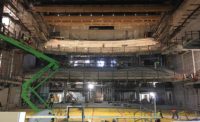On most given days, Pontiac Ceiling and Partition and Turner Brooks Inc. are competitors. The former is located in Pontiac and the other one in Madison Heights, both northern suburbs of Detroit. Yet, when it came to constructing a very high profile project in downtown Detroit, the muscle and skills of both made sense for the companies to team up and deliver a knock out project.
Little Caesars Arena in The District Detroit serves as the home of the Detroit Red Wings, Detroit Pistons and countless other sports, entertainment and community events. The District Detroit is 50 blocks of thriving businesses, parks, restaurants, bars and event destinations.
Rich with the tradition of the “Original Six” Detroit Red Wings and Detroit’s incredible musical heritage, the arena also features state-of-the-art technology, fan amenities, and active community spaces like The Via, the BELFOR Training Center, and the Chevrolet Plaza.
This project will also house Wayne State University’s Mike Ilitch School of Business. (Ilitch was a renowned tycoon that started Little Caesars Pizza, among other companies. The family’s empire also includes Olympia Development, which also has offices in and adjacent to The District Detroit.)
Pontiac Ceiling and Partition has been around for 38 years. The company is a subsidiary of National Construction Enterprises, which is comprised of specialty contractors providing service to the construction industry. Its subsidiaries are located also in Ohio, Indiana and Florida.
Project Profile
» Project: Little Caesars Arena, Detroit
» Owner: Olympia Development of Michigan LLC
» Architect: HOK, Kansas City, Mo.
» Construction Managers: Barton Malow/Hunt, a joint venture in association with White Construction
» Four estimators took five weeks to assemble a plus $20 million contract.
» 17.5 miles of walls, 37 acres of gypsum board hung.
Pontiac Ceiling and Partition specializes in interior and exterior finishes in the commercial construction industry. The company utilizes union carpenters, tapers, laborers and plasterers, who provide services to numerous project types, including healthcare, hospitality, entertainment, retail, educational, government, business and houses of worship.
The contractor specializes in light gauge metal framing, exterior panel systems, gypsum drywall systems, glass fiber reinforced gypsum (GFRG), EIFS, cement and veneer plaster, rough and finish carpentry, custom millwork and cabinetry, spray-on and intumescent fireproofing, doors/frames/hardware, firestopping systems, acoustical ceiling and wall panel systems, demountable partitions, operable folding partitions, as well as small general contracting, door service/repairs and building maintenance services.
Turner Brooks—for all intents and purposes—likewise focuses on the same services but also has a flooring division. The company has been in business
for 84 years.
The make-up of both businesses seems approximately each having around 20 to 30 office workers and field personnel ranges from 100 to 140.
“Business is good now. While we may never see the late-’90s type of volume, the last five years have been very good and very steady,” says Pontiac Ceiling and Partition President Phil Ruffin. “We can see this continuing at least for the next two years minimum.” Turner Brooks’ President Robert Halik also states that business is great for the company as well, the strongest it’s been in two decades.
Joint Venture
Although the two companies in general are competitors, each presumably saw that it made sense to form a joint venture as a means to pool its resources, create a doubly talent field staff and the like.
“A project like The District Detroit Project comes around once or twice in a career,” says Ruffin. “Of course, we wanted to be a part of this massive undertaking, utilizing our resources to the maximum affect. However, we are always looking at risk/reward scenarios and what an undertaking of this magnitude would have on our existing operations. This is one of the main reasons PCP and Turner Brooks joined forces. By forming a 50/50 joint venture, we teamed our resources, increased our chances of securing the project and limited our overall liability.”
Once the project was secured, the two teams meshed nicely together from day one, says Ruffin. Each team provided “key” personnel in the field, in order to guarantee the success of the project. As the project became more demanding, the companies had no issues providing additional field manpower, loading up of daily truckloads of materials and keeping up with the daily changes in scope. In addition, its field crews worked the last seven months of the project, seven days a week, non-stop, staying on top and ahead of schedule.
The scope of the project for The District Detroit consisted of exterior wall framing/sheathing, interior walls, ceilings, specialty ceilings, doors/frames, Lapendary acoustic baffle panels and scaffolding. Specific manufacturers and lines include Hunter Douglas Ceilings, Gordon trims, grid and Gondola Panels, Decoustics acoustical wall panels and Formglas column enclosures. Hunter Douglas assisted the contractors by supplying pre-mitered panel joints on the vault to limit labor during installation.
Victoria Anderson, Hunter Douglas’ design specialist, worked with the architects HOK in the design phases to assist with bringing an appropriate material and finish to this vaulted area. Aluminum 6-inch linear metal with a wood-look powder-coat finish was selected. John Rice, an experienced independent agent representing a deep line card in Division 9, worked with the local contractors through the bidding and coordination stages.
This project required 3,151 individual pieces of Hunter Douglas’s Box 6 linear panels. Each panel was custom back-cut to form a mitered angle to create the slope intersections. This service saved the jobsite contractors time and money on the jobsite by being able to pull material out of a box and focus on the installation.
“There was a significant amount of specialty ceilings installed, with many different varieties, long lead times, and detailed shop drawings,” says Ruffin. “All came in on time and without a hitch. The team faced many unique designs, from high end wood ceilings in the luxury suites to challenging curved drop and wall framing. One of the biggest challenges was the light gauge framing of the sky Gondola box seats. Gondolas are built from steel suspended from the roof of the arena, thus allowing unobstructed views for seats behind them.
“Our team spent months working with the owner’s design team and construction manager, on turning the drawing into reality,” he continues. “We had scaffold (Safeway Scaffold) on both sides of the arena from the bowl below to reach the steel of the Gondolas. From there multiple unforeseen field conditions where encountered and overcome.”
Both companies seem equally satisfied with this project and view it among those that it is most proud of during their own personal careers. And it should, as this project signifies even further growth of Detroit, a city that not even a decade ago filed for bankruptcy and has been plagued with blight, crime and graft on all levels. The District Detroit project shows how far a depressed city can come in just a short amount of time.
“The completion of this project ranks right up there [for career achievements],” says Ruffin. “With the newly formed team and the many challenges the project brought, we’d like to do it all over again. A proud achievement for both companies. Also, being in business for 84 years for Turner Brooks and 38 years for PCP is an achievement that only a few of our competition can brag about.”










Report Abusive Comment